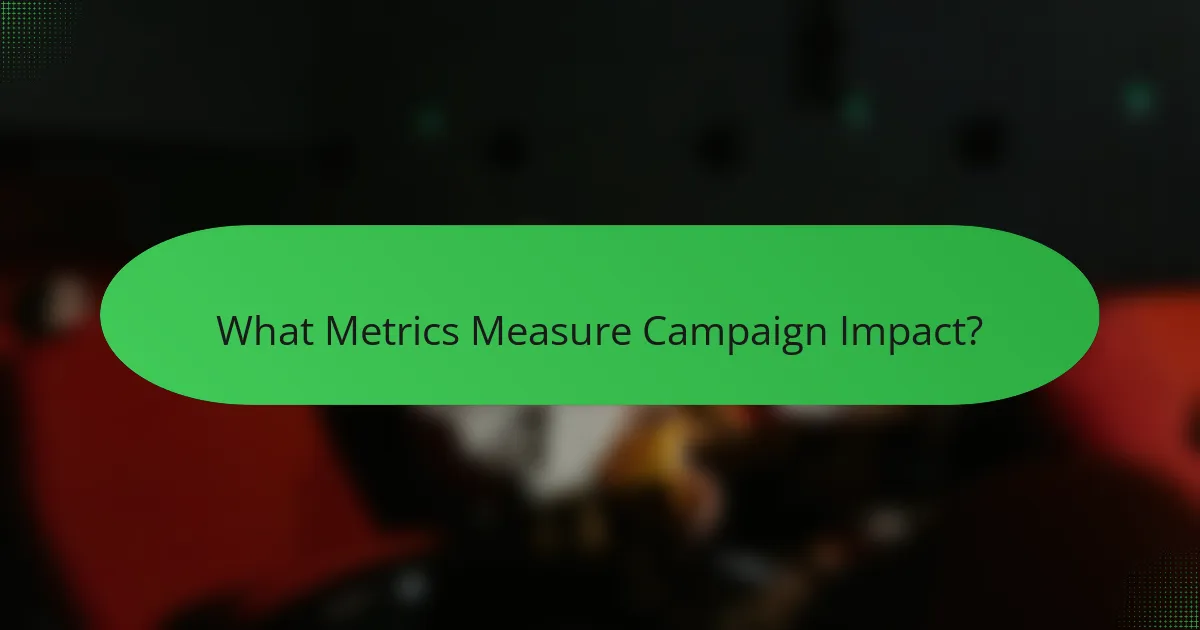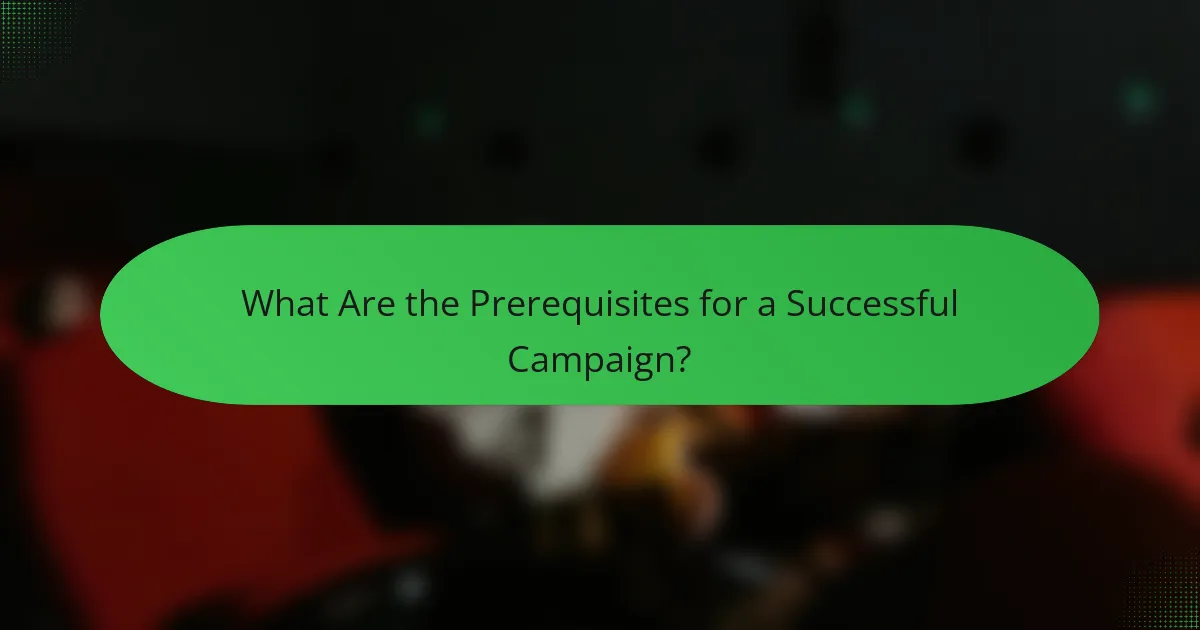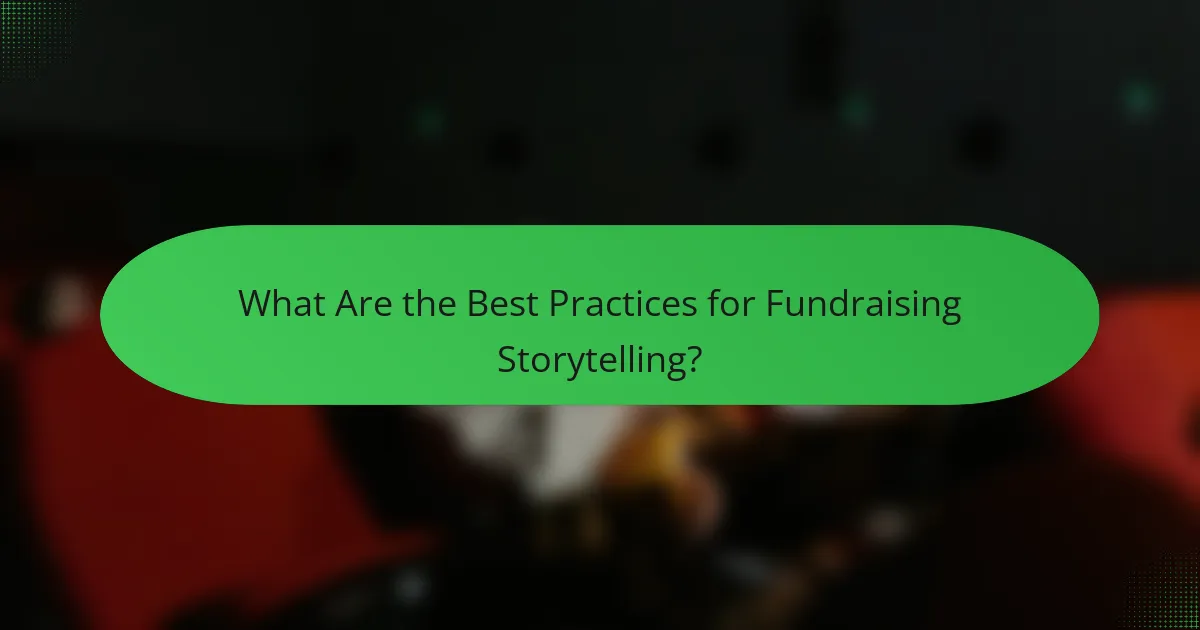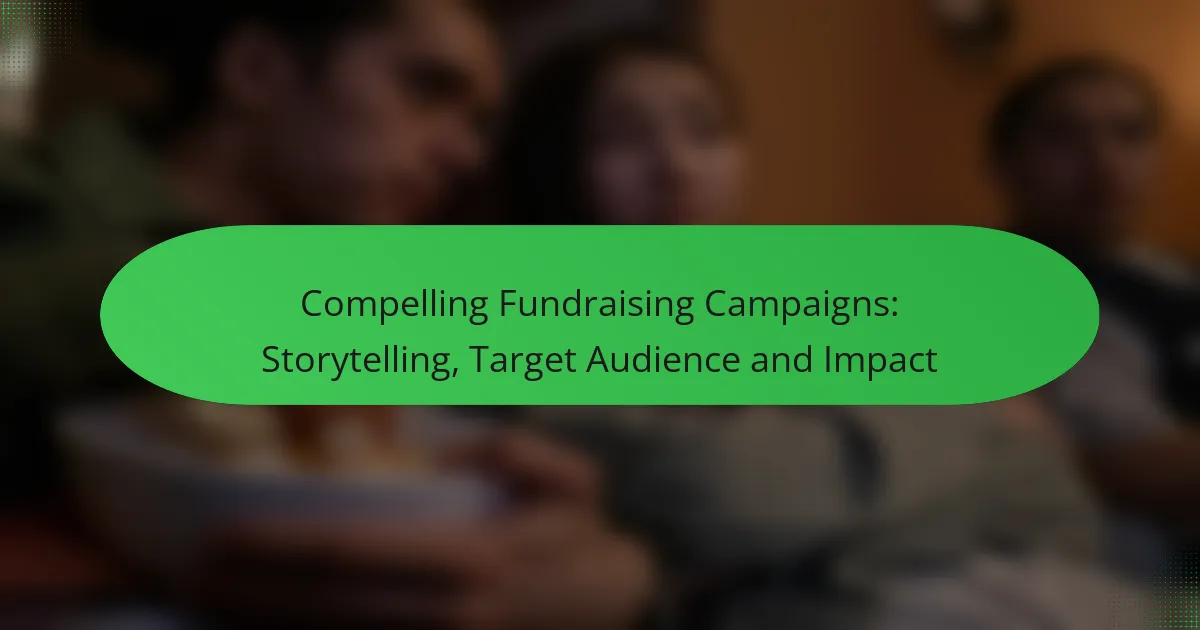Compelling fundraising campaigns hinge on the art of storytelling, a deep understanding of the target audience, and a clear assessment of the impact. By weaving narratives that resonate emotionally, organizations can forge memorable connections that inspire potential donors. Tailoring messages to the specific interests and motivations of the audience is essential for maximizing engagement and driving contributions effectively.

How to Create Compelling Fundraising Campaigns?
Creating compelling fundraising campaigns involves crafting a strong narrative, understanding your audience, and assessing the impact of your efforts. These elements work together to engage potential donors and drive contributions effectively.
Utilize storytelling techniques
Storytelling is a powerful tool in fundraising, as it helps to create an emotional connection with potential donors. By sharing personal stories or impactful testimonials, you can illustrate the real-world effects of donations and inspire action.
Consider using various formats for storytelling, such as videos, blog posts, or social media updates. Each format can reach different audiences, so tailor your approach based on where your supporters are most active.
Identify target audience
Understanding your target audience is crucial for a successful fundraising campaign. Identify demographics such as age, interests, and giving history to tailor your messaging and outreach strategies effectively.
Segment your audience into groups based on their motivations for giving. For example, some may be driven by personal connections to your cause, while others may respond to statistics and data. This allows for more personalized and effective communication.
Measure campaign impact
Measuring the impact of your fundraising campaign helps you understand what works and what doesn’t. Use key performance indicators (KPIs) such as total funds raised, donor retention rates, and engagement metrics to evaluate success.
Regularly review these metrics to adjust your strategies in real-time. For instance, if a particular storytelling approach resonates well, consider amplifying that method in future campaigns to maximize your impact.

What Storytelling Techniques Are Effective?
Effective storytelling techniques in fundraising campaigns engage the audience emotionally and create a memorable connection. By using narratives that resonate with the target audience, organizations can enhance their impact and drive donations.
Emotional narratives
Emotional narratives tap into the feelings of the audience, making them more likely to connect with the cause. These stories often highlight personal struggles, triumphs, or the transformative power of support, which can evoke empathy and motivate action.
To craft an emotional narrative, focus on specific moments that illustrate the impact of your work. Use vivid language and relatable characters to draw the audience in, making them feel invested in the outcome.
Personal testimonials
Personal testimonials provide authentic voices that can validate your organization’s mission. When individuals share their experiences, it adds credibility and relatability, encouraging potential donors to see the real-world effects of their contributions.
Collect testimonials from beneficiaries, volunteers, or supporters, and present them in various formats, such as written quotes, video interviews, or social media posts. Ensure these stories reflect diverse perspectives to reach a broader audience.
Visual storytelling
Visual storytelling uses images, videos, and infographics to convey messages quickly and effectively. This technique captures attention and can often communicate complex ideas more clearly than text alone.
Incorporate high-quality visuals that complement your narrative, such as before-and-after photos or infographics that illustrate your impact. Ensure that visuals are culturally relevant and resonate with your target demographic to maximize engagement.

Who Is Your Target Audience for Fundraising?
Your target audience for fundraising consists of individuals or groups who are likely to support your cause, whether through donations, volunteer work, or advocacy. Understanding this audience is crucial for tailoring your messaging and maximizing engagement.
Demographic analysis
Demographic analysis involves examining characteristics such as age, gender, income level, education, and geographic location. For instance, younger audiences may prefer digital campaigns, while older donors might respond better to traditional methods. Segmenting your audience based on these factors can help you craft more effective fundraising strategies.
Consider using surveys or existing data to gather demographic information. This can guide your outreach efforts and ensure that your campaigns resonate with the right people.
Psychographic profiling
Psychographic profiling focuses on the values, interests, and lifestyles of your target audience. Understanding what motivates potential donors can help you connect on a deeper level. For example, individuals who prioritize environmental issues may be more inclined to support a conservation project.
Utilize focus groups or social media analytics to gain insights into the attitudes and beliefs of your audience. This information can inform your storytelling and messaging, making it more compelling and relatable.
Engagement strategies
Effective engagement strategies are essential for converting interest into action. Tailor your communication channels to match your audience’s preferences, whether through social media, email, or in-person events. For example, younger donors may engage more through Instagram campaigns, while older supporters might appreciate newsletters or community gatherings.
Incorporate storytelling that highlights the impact of donations. Share success stories and testimonials to create an emotional connection. Regularly update your audience on progress and outcomes to maintain their interest and encourage ongoing support.

What Metrics Measure Campaign Impact?
To evaluate the impact of a fundraising campaign, key metrics such as donation amounts, engagement rates, and social media reach should be analyzed. These metrics provide insights into financial success, audience involvement, and overall visibility.
Donation amounts
Donation amounts are a primary indicator of campaign success. They reflect the total funds raised and can be broken down into average donations, total contributions, and the number of unique donors. Tracking these figures helps assess whether fundraising goals are met.
Consider setting specific financial targets based on previous campaigns or industry benchmarks. For example, a campaign might aim to raise between $5,000 and $20,000, depending on its scale and audience. Regularly reviewing donation trends can inform adjustments to strategies.
Engagement rates
Engagement rates measure how actively your audience interacts with your campaign. This can include metrics such as email open rates, click-through rates, and participation in events. High engagement often correlates with increased donations.
To improve engagement, focus on creating compelling content that resonates with your target audience. For instance, personalized emails can boost open rates by 20-30%. Regularly analyze engagement data to refine your messaging and outreach efforts.
Social media reach
Social media reach indicates how many people see your campaign content across platforms like Facebook, Instagram, and Twitter. This metric helps gauge the effectiveness of your promotional efforts and the potential for viral sharing.
To enhance social media reach, consider using targeted ads and engaging visuals. Aim for a reach that exceeds your follower count, ideally by 50-100%, to maximize visibility. Regularly track engagement metrics such as likes, shares, and comments to understand audience reactions and adjust your strategy accordingly.

What Are the Prerequisites for a Successful Campaign?
A successful fundraising campaign requires clear objectives and effective budget planning. These foundational elements guide the campaign’s strategy and ensure resources are allocated efficiently to maximize impact.
Clear objectives
Establishing clear objectives is crucial for any fundraising campaign. Objectives should be specific, measurable, achievable, relevant, and time-bound (SMART). For example, aiming to raise $50,000 within three months for a local charity can provide a focused target.
Consider the audience and the cause when setting objectives. Tailoring goals to resonate with potential donors increases engagement. For instance, if targeting environmentally conscious donors, framing objectives around sustainability can enhance appeal.
Budget planning
Effective budget planning is essential to ensure that a fundraising campaign operates within its financial means. Start by estimating costs associated with marketing, events, and outreach efforts. A typical range for campaign expenses might be 10-20% of the total fundraising goal.
Monitor expenses closely and adjust as necessary to avoid overspending. Utilize tools like spreadsheets to track costs and revenues. Additionally, consider potential funding sources or sponsorships to offset expenses, which can help maximize the net funds raised.

How to Optimize Fundraising Campaigns for Digital Platforms?
To optimize fundraising campaigns for digital platforms, focus on engaging storytelling, understanding your target audience, and measuring impact effectively. Utilizing the right digital tools can significantly enhance your outreach and fundraising success.
Utilize social media advertising
Social media advertising is a powerful way to reach potential donors where they spend a lot of their time. Platforms like Facebook, Instagram, and Twitter allow targeted ads that can be customized based on demographics, interests, and behaviors.
Consider allocating a budget for paid ads to boost visibility. Start with a small investment to test different ad formats and messages, then scale up based on performance. Monitor engagement rates to refine your approach continuously.
Leverage email marketing
Email marketing remains a cost-effective strategy for fundraising campaigns. Build a targeted email list of supporters and potential donors, and segment them based on their interests and past interactions with your organization.
Craft compelling email content that tells a story and clearly outlines the impact of donations. Aim for a consistent schedule, such as monthly newsletters or campaign updates, to keep your audience engaged. Use A/B testing to determine which subject lines and content resonate best.
Implement SEO strategies
Search Engine Optimization (SEO) is crucial for increasing the visibility of your fundraising campaigns online. Optimize your website and content for relevant keywords that potential donors might use when searching for causes to support.
Focus on creating high-quality, informative content that addresses your audience’s interests and concerns. Regularly update your website with blog posts, success stories, and campaign updates to improve search rankings. Consider local SEO tactics if your campaign targets specific geographic areas.

What Are the Best Practices for Fundraising Storytelling?
Effective fundraising storytelling involves crafting narratives that resonate with your audience and drive engagement. By focusing on emotional connections, clear messaging, and relatable characters, organizations can inspire potential donors to contribute meaningfully.
Know Your Audience
Understanding your target audience is crucial for effective storytelling in fundraising. Tailor your message to reflect the values, interests, and demographics of your potential donors. For instance, younger audiences may respond better to digital storytelling formats, while older generations might prefer traditional methods.
Consider conducting surveys or analyzing past donor behavior to gather insights. This data can help you create personas that guide your storytelling approach, ensuring it aligns with what resonates most with your supporters.
Craft a Compelling Narrative
A compelling narrative should include a clear beginning, middle, and end, focusing on a relatable protagonist who faces challenges that your organization addresses. Highlight personal stories that illustrate the impact of donations, making the cause tangible and urgent.
Utilize emotional triggers, such as hope, empathy, or urgency, to engage your audience. For example, sharing a success story of an individual or community that benefited from your organization can create a powerful connection that encourages donations.
Use Visuals Effectively
Visual elements can enhance storytelling by making it more engaging and memorable. Incorporate high-quality images, videos, or infographics that complement your narrative and illustrate the impact of contributions. Visuals should evoke emotions and provide context to the story being told.
Ensure that your visuals are relevant and culturally appropriate for your audience. For instance, if fundraising for a local cause, using images from the community can strengthen the connection and encourage local support.
Call to Action
A strong call to action (CTA) is essential in fundraising storytelling. Clearly articulate what you want your audience to do after engaging with your story, whether it’s donating, sharing the message, or volunteering. Make the CTA specific, actionable, and easy to follow.
For example, instead of a generic “donate now,” use phrases like “Help us provide meals to 100 families this month” to create urgency and a sense of purpose. This specificity can significantly increase conversion rates and donor engagement.
